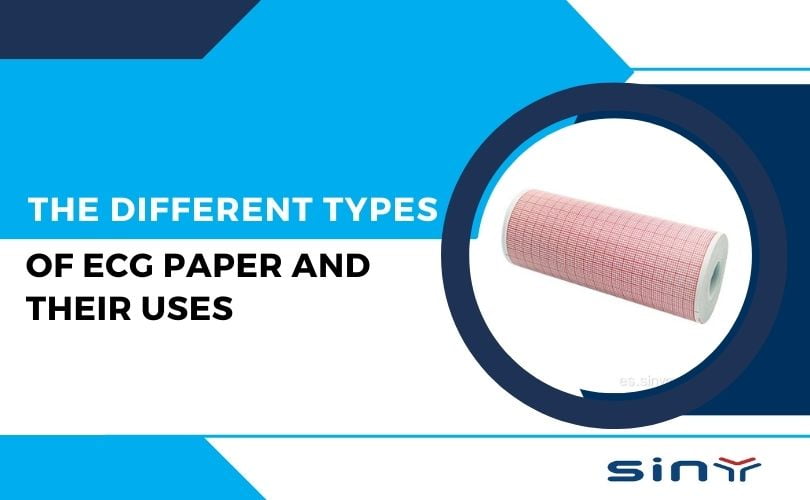ECG paper, also known as ECG recording papers, heart test, cardiology paper, or fetal monitoring, is made from thermal paper used in medical settings to record the heart’s electrical activity. Siny Medical offers a comprehensive line of ECG paper to ensure accurate tracings and seamless device compatibility.
Electrocardiograms (ECGs) are vital medical diagnostic tools, allowing healthcare professionals to monitor and analyze the heart’s electrical activity. A critical component of this process is the ECG paper used to print the readings. Understanding the different types and their specific uses is essential for healthcare providers to ensure accurate diagnostics and effective patient care.
Table of Contents
- 1 What is an ECG paper?
- 2 Types of ECG Paper
- 3 Features of ECG Paper
- 4 The Importance of Choosing the Right ECG Paper
- 5 Conclusion
- 6 FAQs
- 6.1 What are the main differences between sheet and roll-style ECG paper?
- 6.2 How do I ensure the compatibility of ECG paper with my machine?
- 6.3 What should I do if I accidentally order the wrong type of ECG paper?
- 6.4 How does the quality of ECG thermal paper impact diagnostic accuracy?
- 6.5 Why is high-quality ECG thermal paper essential for hospitals?
What is an ECG paper?
ECG paper is a specialized type used in electrocardiography to record the heart’s electrical impulses. It is designed to work with ECG machines, which use heat to create heart activity tracings. The quality of the ECG paper can significantly impact the clarity and accuracy of the readings, making it crucial for healthcare providers to choose the right type.
Types of ECG Paper
ECG paper comes in various formats, each with unique characteristics and applications. Here are the most common types:
Thermal ECG Paper
Thermal ECG paper is the most widely used type in modern electrocardiography. It is coated with a thermosensitive layer that reacts to heat, allowing ECG machines to print heart tracings without ink.

- Uses: This type of paper is ideal for hospitals and clinics where quick and reliable readings are essential. It provides high-quality images that are crucial for accurate diagnosis and monitoring.
- Advantages: Thermal paper offers excellent clarity, durability, and resistance to fading. High-quality thermal ECG paper can last 8 to 20 years, making it suitable for long-term patient records.
Z-Fold ECG Paper
Z-fold ECG paper is designed in a fan-folded format, allowing easy handling and storage. Each sheet is pre-folded in a zigzag pattern, making it convenient for printers requiring sheet paper.
- Uses: This type is commonly used in outpatient settings and smaller clinics where ECG machines are rarely used.
- Advantages: Z-fold paper is easy to load into machines and minimizes the risk of paper jams. It also allows quick access to printed results, which is beneficial in busy clinical environments.
Roll ECG Paper
Roll ECG paper is another standard format, available in various widths and lengths.

- Uses: Roll paper is ideal for hospitals and cardiology clinics where continuous monitoring is required, such as during stress tests or extended ECG recordings.
- Advantages: The roll format allows for uninterrupted printing, making it efficient for capturing long-term data. It also provides flexibility in terms of length, as healthcare facilities can choose rolls that fit their specific needs.
Sheet ECG Paper
Sheet ECG paper comes in individual sheets, typically in an f-fold pattern. This type is less common than thermal and roll paper but still finds use in specific clinical settings.
- Uses: Medical schools often use sheets in educational environments to practice ECG interpretation.
- Advantages: Sheets are easy to handle and offer a tangible way for students to learn about ECG readings, making them ideal for teaching purposes
Features of ECG Paper
High-Quality Print
Crafted from top-grade thermal paper, our ECG paper delivers a sharp, durable print that helps medical professionals capture even the finest details.
Precision Grid Lines
With advanced printing technology, our ECG paper showcases clear and accurate grid lines, aiding in precise cardiac measurements.
Wide Compatibility
Designed to work seamlessly with various ECG machines, our paper ensures effortless integration into your healthcare setup, eliminating compatibility concerns.
Smooth Surface
Our ECG paper offers a smooth surface that ensures flawless printing, preventing smudges and ensuring precise, readable results for accurate diagnosis.
The Importance of Choosing the Right ECG Paper
Selecting the appropriate ECG paper is critical for several reasons:
- Accuracy of Readings: The quality of the ECG paper directly impacts the accuracy of the heart’s electrical tracings. Clear and precise printouts are essential for effective diagnosis and treatment planning.
- Patient Safety: Accurate ECG readings are vital for patient safety. Misinterpretations due to poor-quality paper can lead to incorrect diagnoses and treatment decisions.
- Legal Documentation: ECG recordings serve as official medical records. High-quality paper ensures that these documents remain legible and intact for future reference, which is crucial for legal and compliance purposes.
Conclusion
In conclusion, understanding the different types of ECG paper and their specific uses is essential for healthcare providers involved in cardiac diagnostics. Whether using thermal, Z-fold, roll, or sheet ECG paper, the choice can significantly impact the quality of readings and patient care. Healthcare professionals can ensure accurate diagnoses, enhance patient safety, and maintain reliable medical records by selecting high-quality, compatible equipment that meets their clinical needs.
As technology continues to evolve, the importance of reliable ECG paper in capturing the heart’s electrical activity remains a cornerstone of effective cardiology practice. Investing in the right invests in quality patient care and accurate medical diagnostics.
With over 20 years of industry expertise, Siny Medical is your trusted partner for superior-quality ECG paper at competitive prices—experience reliability and precision with every print. Explore our ECG paper range now!
FAQs
What are the main differences between sheet and roll-style ECG paper?
Machines typically use sheet-style ECG paper to print shorter, individual test strips, making it ideal for stationary or desktop ECG units. In contrast, machines requiring longer strips use roll-style ECG paper, which comes in a continuous roll. These uninterrupted strips are handy for constant monitoring in hospital settings or during extended cardiac tests.
How do I ensure the compatibility of ECG paper with my machine?
Check your ECG machine’s model and manufacturer’s specifications to ensure compatibility. Look for the recommended paper size, type, and format (sheet or roll) in the user manual or the manufacturer’s website. Additionally, confirm whether the machine requires specific brands or grades of thermal paper to function optimally.
What should I do if I accidentally order the wrong type of ECG paper?
If you mistakenly ordered the wrong type of ECG paper, first check the supplier’s return or exchange policy. Most reputable vendors will allow you to return unopened packages for a refund or exchange.
How does the quality of ECG thermal paper impact diagnostic accuracy?
High-quality ECG thermal paper produces clear, precise prints with well-defined grid lines and traces. This clarity is crucial for accurately interpreting the heart’s electrical activity. Low-quality paper can result in faded prints, smudges, or inconsistencies, which might lead to misinterpretation of the data and potentially impact the accuracy of the diagnosis.
Why is high-quality ECG thermal paper essential for hospitals?
High-quality ECG thermal paper is essential in hospitals because it ensures reliable, consistent results for accurate diagnoses. Hospitals rely on clear and precise ECG readings to make informed decisions about patient care. Using top-grade paper minimizes the risk of misreading due to poor print quality and supports better patient outcomes.



























































